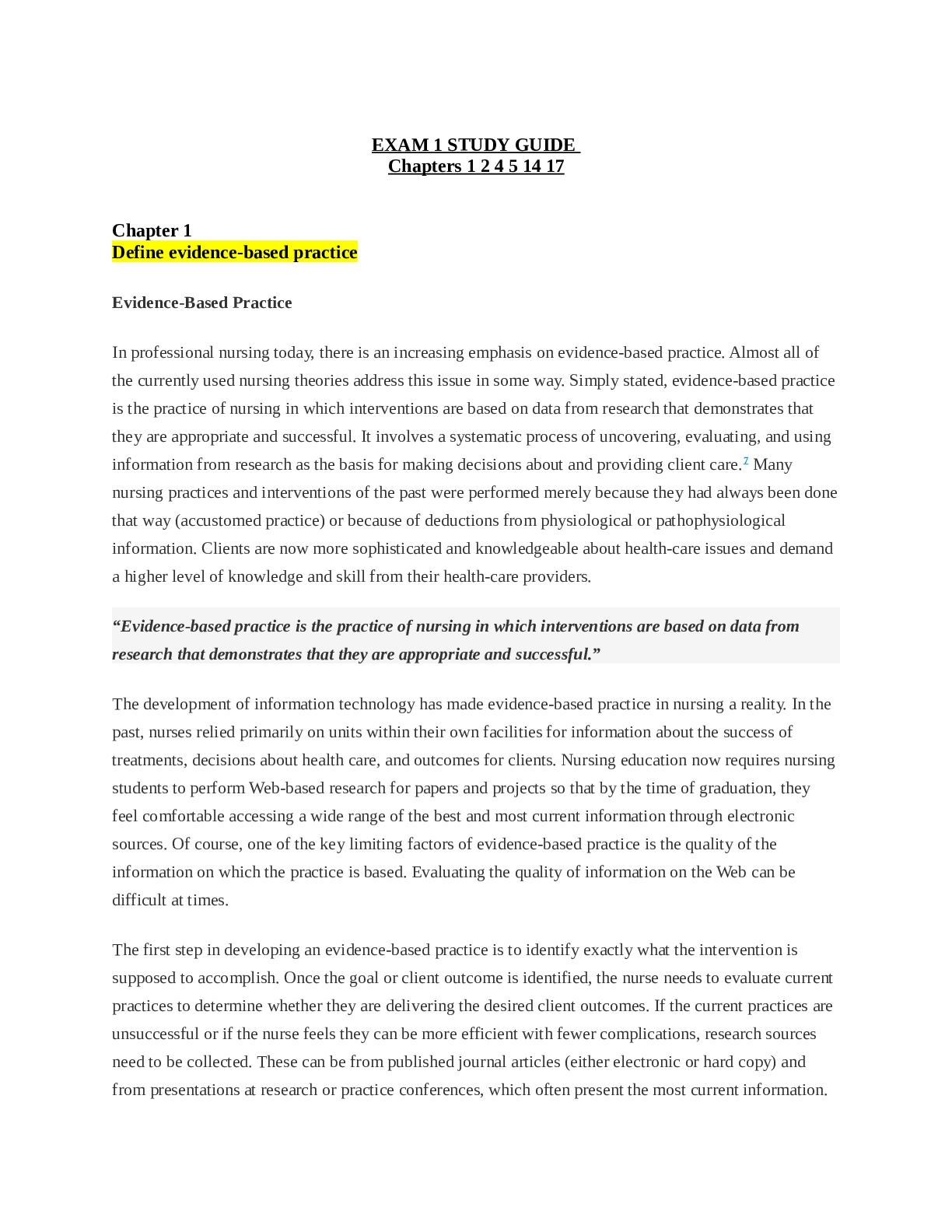Chapter 1
Define evidence-based practice
Evidence-Based Practice
In professional nursing today, there is an increasing emphasis on evidence-based practice. Almost all of
the currently used nursing theories address this issue in some way. Simply stated, evidence-based practice
is the practice of nursing in which interventions are based on data from research that demonstrates that
they are appropriate and successful. It involves a systematic process of uncovering, evaluating, and using
information from research as the basis for making decisions about and providing client care. 7 Many
nursing practices and interventions of the past were performed merely because they had always been done
that way (accustomed practice) or because of deductions from physiological or pathophysiological
information. Clients are now more sophisticated and knowledgeable about health-care issues and demand
a higher level of knowledge and skill from their health-care providers.
“Evidence-based practice is the practice of nursing in which interventions are based on data from
research that demonstrates that they are appropriate and successful.”
The development of information technology has made evidence-based practice in nursing a reality. In the
past, nurses relied primarily on units within their own facilities for information about the success of
treatments, decisions about health care, and outcomes for clients. Nursing education now requires nursing
students to perform Web-based research for papers and projects so that by the time of graduation, they
feel comfortable accessing a wide range of the best and most current information through electronic
sources. Of course, one of the key limiting factors of evidence-based practice is the quality of the
information on which the practice is based. Evaluating the quality of information on the Web can be
difficult at times.
The first step in developing an evidence-based practice is to identify exactly what the intervention is
supposed to accomplish. Once the goal or client outcome is identified, the nurse needs to evaluate current
practices to determine whether they are delivering the desired client outcomes. If the current practices are
unsuccessful or if the nurse feels they can be more efficient with fewer complications, research sources
need to be collected. These can be from published journal articles (either electronic or hard copy) and
from presentations at research or practice conferences, which often present the most current information.
Then a plan should be developed to implement the new findings. This process can be applied to changing
policy and procedures or developing training programs for facility staff. Research data should always be
used when initiating new practices or modifying old ones.
Review difference between roles: position, job, occupation, profession, professional, and what is
professionalism
Position: A group of tasks assigned to one individual
Job: A group of positions similar in nature and level of skill that can be carried out by one or
more individuals
Occupation: A group of jobs similar in type of work that are usually found throughout an
industry or work environment
Profession: A type of occupation that requires prolonged preparation and formal qualifications
and meets certain higher level criteria (discussed later in this chapter) that raise it to a level above that
of an occupation1
Professional: A person who belongs to and practices a profession (The term professional is
probably the most misused of all these terms when describing people who are clearly involved in jobs
or occupations, such as a “professional truck driver,” “professional football player,” or even
“professional thief.”)
Professionalism: The demonstration of high-level personal, ethical, and skill characteristics of a
member of a profession 2
Identify the traits that define a profession
Trait Approach
Of the many researchers and theorists who have attempted to identify the traits that define a profession,
Abraham Flexner, Elizabeth Bixler, and Eliza Pavalko are most widely accepted as the leaders in the
field. These three social scientists have determined that the following common characteristics are
important:
• High intellectual level
• High level of individual responsibility and accountability
• Specialized body of knowledge
• Knowledge that can be learned in institutions of higher education
• Public service and altruistic activities
• Public service valued over financial gain
• Relatively high degree of autonomy and independence of practice
Read More
.png)

